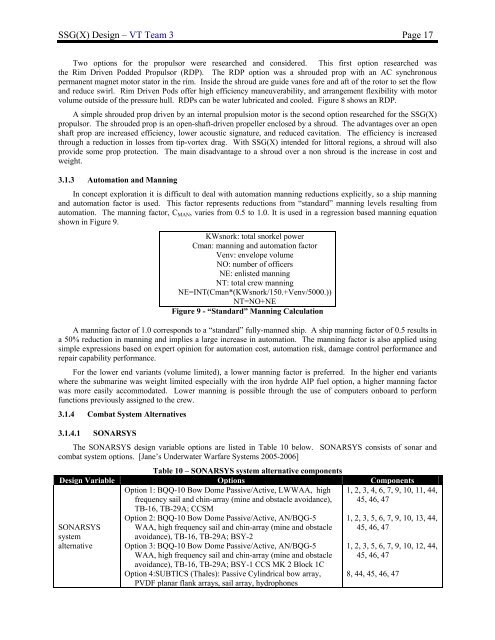Design Report Guided Missile Submarine SSG(X) - AOE - Virginia ...
Design Report Guided Missile Submarine SSG(X) - AOE - Virginia ...
Design Report Guided Missile Submarine SSG(X) - AOE - Virginia ...
Create successful ePaper yourself
Turn your PDF publications into a flip-book with our unique Google optimized e-Paper software.
<strong>SSG</strong>(X) <strong>Design</strong> – VT Team 3 Page 17<br />
Two options for the propulsor were researched and considered. This first option researched was<br />
the Rim Driven Podded Propulsor (RDP). The RDP option was a shrouded prop with an AC synchronous<br />
permanent magnet motor stator in the rim. Inside the shroud are guide vanes fore and aft of the rotor to set the flow<br />
and reduce swirl. Rim Driven Pods offer high efficiency maneuverability, and arrangement flexibility with motor<br />
volume outside of the pressure hull. RDPs can be water lubricated and cooled. Figure 8 shows an RDP.<br />
A simple shrouded prop driven by an internal propulsion motor is the second option researched for the <strong>SSG</strong>(X)<br />
propulsor. The shrouded prop is an open-shaft-driven propeller enclosed by a shroud. The advantages over an open<br />
shaft prop are increased efficiency, lower acoustic signature, and reduced cavitation. The efficiency is increased<br />
through a reduction in losses from tip-vortex drag. With <strong>SSG</strong>(X) intended for littoral regions, a shroud will also<br />
provide some prop protection. The main disadvantage to a shroud over a non shroud is the increase in cost and<br />
weight.<br />
3.1.3 Automation and Manning<br />
In concept exploration it is difficult to deal with automation manning reductions explicitly, so a ship manning<br />
and automation factor is used. This factor represents reductions from “standard” manning levels resulting from<br />
automation. The manning factor, CMAN, varies from 0.5 to 1.0. It is used in a regression based manning equation<br />
shown in Figure 9.<br />
KWsnork: total snorkel power<br />
Cman: manning and automation factor<br />
Venv: envelope volume<br />
NO: number of officers<br />
NE: enlisted manning<br />
NT: total crew manning<br />
NE=INT(Cman*(KWsnork/150.+Venv/5000.))<br />
NT=NO+NE<br />
Figure 9 - “Standard” Manning Calculation<br />
A manning factor of 1.0 corresponds to a “standard” fully-manned ship. A ship manning factor of 0.5 results in<br />
a 50% reduction in manning and implies a large increase in automation. The manning factor is also applied using<br />
simple expressions based on expert opinion for automation cost, automation risk, damage control performance and<br />
repair capability performance.<br />
For the lower end variants (volume limited), a lower manning factor is preferred. In the higher end variants<br />
where the submarine was weight limited especially with the iron hydrde AIP fuel option, a higher manning factor<br />
was more easily accommodated. Lower manning is possible through the use of computers onboard to perform<br />
functions previously assigned to the crew.<br />
3.1.4 Combat System Alternatives<br />
3.1.4.1 SONARSYS<br />
The SONARSYS design variable options are listed in Table 10 below. SONARSYS consists of sonar and<br />
combat system options. [Jane’s Underwater Warfare Systems 2005-2006]<br />
Table 10 – SONARSYS system alternative components<br />
<strong>Design</strong> Variable Options Components<br />
Option 1: BQQ-10 Bow Dome Passive/Active, LWWAA, high 1, 2, 3, 4, 6, 7, 9, 10, 11, 44,<br />
frequency sail and chin-array (mine and obstacle avoidance),<br />
TB-16, TB-29A; CCSM<br />
45, 46, 47<br />
Option 2: BQQ-10 Bow Dome Passive/Active, AN/BQG-5 1, 2, 3, 5, 6, 7, 9, 10, 13, 44,<br />
SONARSYS WAA, high frequency sail and chin-array (mine and obstacle 45, 46, 47<br />
system<br />
avoidance), TB-16, TB-29A; BSY-2<br />
alternative Option 3: BQQ-10 Bow Dome Passive/Active, AN/BQG-5 1, 2, 3, 5, 6, 7, 9, 10, 12, 44,<br />
WAA, high frequency sail and chin-array (mine and obstacle<br />
avoidance), TB-16, TB-29A; BSY-1 CCS MK 2 Block 1C<br />
45, 46, 47<br />
Option 4:SUBTICS (Thales): Passive Cylindrical bow array,<br />
PVDF planar flank arrays, sail array, hydrophones<br />
8, 44, 45, 46, 47

















